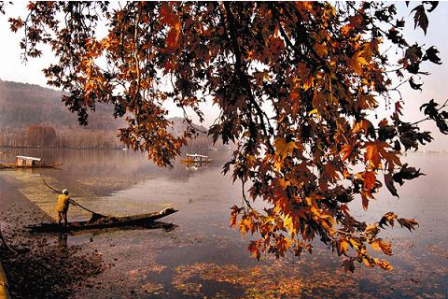Srinagar : As autumn, the golden yellow season of Kashmir, draws to a close, the majestic chinar trees are at their fiery best. Their crimson coloured leaves – so rightly dubbed ‘flames of the chinar’ – lend a fairytale glow to the scenic valley.
From green to yellow through crimson before they fall to the ground, the leaves of the chinar trees have fired many an imagination for prose and verse.
“Che Nar (What fire)?” – these words of a Persian poet who has visited the valley in the past are still resounding in the majestic chinar gardens of Naseem Bagh in the Kashmir University campus on the banks of the Dal Lake in Srinagar and other places.
Native to Persia, Italy, Belgium, America and Greece, chinar trees were planted on a large scale across the length and breadth of the valley by Mughal emperor Jahangir during his reign from 1605 to 1627 though the origin of the plant in Kashmir is believed to be much earlier than the Mughal period.
Later rulers declared it a protected tree as it became a symbol of Kashmir’s heritage and beauty. Felling of the chinar or even lopping off its branches is forbidden by law.
A 627-year-old chinar tree planted by Sufi saint Syed Abul Qasim Shah Hamdani in 1374 in central Kashmir’s Badgam district is believed to be the oldest of the specie in the world.
“The magic created by the ‘fires of the Chinar’ because of its crimson leaves towards the end of the autumn season is something one has to see to believe,” Bashir Ahmad War, a retired veterinarian, said.
“As dozens of the mighty chinar trees surround the visitor with each one of them radiating its fiery brilliance, the spectacle is simply breathtaking. Anybody looking at them from a distance thinks the entire tree is on fire,” he added.
The valley has some of the finest chinar gardens in Srinagar, Ganderbal, Anantnag and other places where locals and visitors throng these days to take pictures.
Sunil Kumar, a tourist from Punjab, said: “It is a treat to be among the fiery chinars. I am lucky to have chosen this time of the year to visit Kashmir.”
The leaves will finally fall to the ground and become the chief source of charcoal for the locals who collect it from half burnt chinar leaves and fill their ‘kangris’ (earthen firepots woven in willow wicker).
The kangris serve as mobile heaters during the harsh winter months.
It is carried by the locals under their ‘pherans’ (tweed overgarments) and its soothing heat enables Kashmiris to brave even the most bitter winter.
“Despite central heating, electric heaters and electric blankets, the kangri still remains our best insurance against the biting cold,” said Muzaffar Ahmad, a college principal here.
“As the electric supply remains erratic, the traditional dependence of the locals on the kangri continues unchallenged,” he added.
IANS



